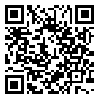Volume 14, Issue 1 (January & February 2023)
BCN 2023, 14(1): 137-142 |
Back to browse issues page
Download citation:
BibTeX | RIS | EndNote | Medlars | ProCite | Reference Manager | RefWorks
Send citation to:



BibTeX | RIS | EndNote | Medlars | ProCite | Reference Manager | RefWorks
Send citation to:
Khamseh F, Hadjati G, Nahvinejad H, Nouparast Z, Salehi M, Noroozian M, et al . Comparing the Diagnostic Value of Four Dementia Tests in the Amnestic and Healthy Elderly. BCN 2023; 14 (1) :137-142
URL: http://bcn.iums.ac.ir/article-1-1457-en.html
URL: http://bcn.iums.ac.ir/article-1-1457-en.html
Fatemah Khamseh1 
 , Gholamreza Hadjati *1
, Gholamreza Hadjati *1 

 , Hossein Nahvinejad2
, Hossein Nahvinejad2 
 , Zahra Nouparast1
, Zahra Nouparast1 

 , Masomeh Salehi1
, Masomeh Salehi1 

 , Maryam Noroozian3
, Maryam Noroozian3 

 , Mahshid Foroughan4
, Mahshid Foroughan4 

 , Farshid Alaedini5
, Farshid Alaedini5 
 , Afrooz Saffarifard2
, Afrooz Saffarifard2 
 , Faraneh Farin1
, Faraneh Farin1 
 , Mehrdad Khansari1
, Mehrdad Khansari1 
 , Maryam Pourseid Mohammad2
, Maryam Pourseid Mohammad2 
 , Zahra Ahmadi2
, Zahra Ahmadi2 



 , Gholamreza Hadjati *1
, Gholamreza Hadjati *1 

 , Hossein Nahvinejad2
, Hossein Nahvinejad2 
 , Zahra Nouparast1
, Zahra Nouparast1 

 , Masomeh Salehi1
, Masomeh Salehi1 

 , Maryam Noroozian3
, Maryam Noroozian3 

 , Mahshid Foroughan4
, Mahshid Foroughan4 

 , Farshid Alaedini5
, Farshid Alaedini5 
 , Afrooz Saffarifard2
, Afrooz Saffarifard2 
 , Faraneh Farin1
, Faraneh Farin1 
 , Mehrdad Khansari1
, Mehrdad Khansari1 
 , Maryam Pourseid Mohammad2
, Maryam Pourseid Mohammad2 
 , Zahra Ahmadi2
, Zahra Ahmadi2 


1- Iranian Association of Alzheimer’s Disease, Tehran, Iran.
2- Iranian State Welfare Organization, Tehran, Iran.
3- Department of Neurology, Tehran University of Medical Sciences, Tehran, Iran.
4- Iranian Research Center on Aging, University of Social Welfare and Rehabilitation Sciences, Tehran, Iran.
5- Shafa Health Research Center, Tehran, Iran.
2- Iranian State Welfare Organization, Tehran, Iran.
3- Department of Neurology, Tehran University of Medical Sciences, Tehran, Iran.
4- Iranian Research Center on Aging, University of Social Welfare and Rehabilitation Sciences, Tehran, Iran.
5- Shafa Health Research Center, Tehran, Iran.
Abstract:
Introduction: This study aimed to compare the diagnostic value of four questionnaires for the diagnosis of neurocognitive disorders (NCDs) in the elderly.
Methods: In this project, people older than 60 years who lived in Tehran were investigated. A total of 99 literate cases were enrolled in the study, and four questionnaires, including functional assessment staging tool (FAST), abbreviated mental test score (AMTS), mini-mental state examination (MMSE), and modified Persian test of elderly for assessment of cognition and executive function (PEACE) were completed for them. They were then referred to a neuropsychiatrist, and the status of their cognition and neurobehavior was determined. The specialists were blinded to the results of the tests.
Results: Of the 99 participants studied, 39 cases were healthy, eight cases had mild Alzheimer’s disease, 38 had amnesic MCI, five cases had secondary dementia, and nine cases had mixed vascular dementia and Alzheimer’s disease. The area under the ROC curve for distinguishing the healthy group from the rest of the population was 0.692, 0.629, 0.734, and 0.751 for the FAST, AMTS, MMSE, and NBCSS questionnaires, respectively.
Conclusion: MMSE and NBCSS tests had better diagnostic power than the other two tests to distinguish the healthy group from the rest of the population.
Methods: In this project, people older than 60 years who lived in Tehran were investigated. A total of 99 literate cases were enrolled in the study, and four questionnaires, including functional assessment staging tool (FAST), abbreviated mental test score (AMTS), mini-mental state examination (MMSE), and modified Persian test of elderly for assessment of cognition and executive function (PEACE) were completed for them. They were then referred to a neuropsychiatrist, and the status of their cognition and neurobehavior was determined. The specialists were blinded to the results of the tests.
Results: Of the 99 participants studied, 39 cases were healthy, eight cases had mild Alzheimer’s disease, 38 had amnesic MCI, five cases had secondary dementia, and nine cases had mixed vascular dementia and Alzheimer’s disease. The area under the ROC curve for distinguishing the healthy group from the rest of the population was 0.692, 0.629, 0.734, and 0.751 for the FAST, AMTS, MMSE, and NBCSS questionnaires, respectively.
Conclusion: MMSE and NBCSS tests had better diagnostic power than the other two tests to distinguish the healthy group from the rest of the population.
Keywords: Alzheimer’s disease, Diagnosis, Mini-mental state examination, Abbreviated mental test score, Functional assessment staging tool
Type of Study: Original |
Subject:
Clinical Neuroscience
Received: 2019/03/16 | Accepted: 2020/11/7 | Published: 2023/01/1
Received: 2019/03/16 | Accepted: 2020/11/7 | Published: 2023/01/1
Send email to the article author
| Rights and permissions | |
 |
This work is licensed under a Creative Commons Attribution-NonCommercial 4.0 International License. |





